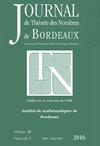投影子的自同态环与Bernstein中心
IF 0.3
4区 数学
Q4 MATHEMATICS
引用次数: 4
摘要
让$F$是本地非阿基米德域,并且$\mathcal{O}_F$的整数环。设$\Omega$是$GL_n(F)$的光滑表示范畴的Bernstein分量,设$(J,\lambda)$是Bushnell-Kutzko$\Omega$类型,设$\mathfrak{Z}_{\Omega}$是Bernstein组件$\Omega$的中心。本文包含两个主要结果。设$\sigma$是$\mathrm的直接和{Ind}_J^{GL_n(\mathcal{O}_F)}\lambda$。我们将从计算$\mathrm{c\text{--}Ind}_{GL_n(\mathcal{O}_F)}^{GL_n(F)}\sigma\otimes_{\mathfrak{Z}_{\Omega}}\kappa(\mathfrak{m})$,其中$\akappa{Z}_{\Omega}$,并且最大理想$\mathfrak{m}$属于$\mathrm{Spec}\中的Zariski稠密集{Z}_{\Omega}$。这个结果使我们能够推断自同态环$\mathrm{End}_{GL_n(F)}(\mathrm{c\text{--}Ind}_{O}_F)}^{GL_n(F)}\sigma)$同构于$\mathfrak{Z}_{\Omega}$,当$\sigma$以多重数1出现在$\mathrm中时{Ind}_J^{GL_n(\mathcal{O}_F)}\lambda$。本文章由计算机程序翻译,如有差异,请以英文原文为准。
The endomorphism ring of projectives and the Bernstein centre
Let $F$ be a local non-archimedean field and $\mathcal{O}_F$ its ring of integers. Let $\Omega$ be a Bernstein component of the category of smooth representations of $GL_n(F)$, let $(J, \lambda)$ be a Bushnell-Kutzko $\Omega$-type, and let $\mathfrak{Z}_{\Omega}$ be the centre of the Bernstein component $\Omega$. This paper contains two major results. Let $\sigma$ be a direct summand of $\mathrm{Ind}_J^{GL_n(\mathcal{O}_F)} \lambda$. We will begin by computing $\mathrm{c\text{--} Ind}_{GL_n(\mathcal{O}_F)}^{GL_n(F)} \sigma\otimes_{\mathfrak{Z}_{\Omega}}\kappa(\mathfrak{m})$, where $\kappa(\mathfrak{m})$ is the residue field at maximal ideal $\mathfrak{m}$ of $\mathfrak{Z}_{\Omega}$, and the maximal ideal $\mathfrak{m}$ belongs to a Zariski-dense set in $\mathrm{Spec}\: \mathfrak{Z}_{\Omega}$. This result allows us to deduce that the endomorphism ring $\mathrm{End}_{GL_n(F)}(\mathrm{c\text{--} Ind}_{GL_n(\mathcal{O}_F)}^{GL_n(F)} \sigma)$ is isomorphic to $\mathfrak{Z}_{\Omega}$, when $\sigma$ appears with multiplicity one in $\mathrm{Ind}_J^{GL_n(\mathcal{O}_F)} \lambda$.
求助全文
通过发布文献求助,成功后即可免费获取论文全文。
去求助
来源期刊

Journal De Theorie Des Nombres De Bordeaux
MATHEMATICS-
CiteScore
0.60
自引率
0.00%
发文量
35
期刊介绍:
The Journal de Théorie des Nombres de Bordeaux publishes original papers on number theory and related topics (not published elsewhere).
 求助内容:
求助内容: 应助结果提醒方式:
应助结果提醒方式:


